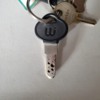.
Um, getting back to the original post.
Like Gordon, I googled and found no corroborating evidence that this device ever existed. And, it seems Winner Int currently makes a bazillion variations of The Club and pretty much nothing else.
No high-tech electronic gimcrackery in their repertoire.
Ah, but they do make a few 'security' devices which are alarm decoys - flashing LED thingies designed to fool bad guys into thinking a real alarm system is on the job - at considerably reduced cost compared to a real alarm system.
I'm wondering if this isn't an earlier Winner attempt at a decoy system and is connected to nothing but a 12V power tap. (They would already have keys and lock sets in the parts bin for all those Clubs they make.)
In which case, the LED shouldn't be enough to drain a healthy battery, so maybe those furtive electrons are finding another escape path to ground, far from the mystery device.
I think I'd start with the usual procedures for checking that - the pulling of fuses and the measuring of amps. Sometimes a sharp lookout for an arc when pulling fuses - one at a time - can be revealing. And that can be more fruitful in a darkened garage.
More and more, though, I'm liking the concept of a fake alarm to protect one of our fake cars.
.




